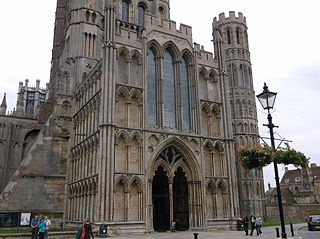
Eustace was the twenty-third Lord Chancellor of England, from 1197 to 1198. He was also Dean of Salisbury and Bishop of Ely.
Godfrey Goodman, also called Hugh; was the Anglican Bishop of Gloucester, and a member of the Protestant Church. He was the son of Godfrey Goodman (senior) and Jane Croxton, landed gentry living in Wales. His contemporaries describe him as being a hospitable, quiet man, and lavish in his charity to the poor.

The bishop of London is the ordinary of the Church of England's Diocese of London in the Province of Canterbury. By custom the Bishop is also Dean of the Chapel Royal since 1723.
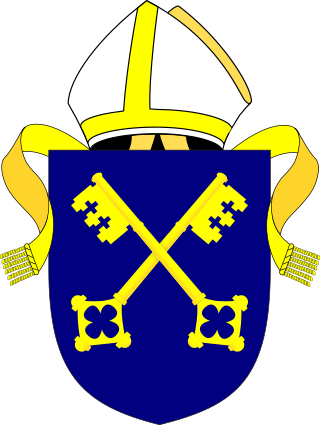
The Diocese of Gloucester is a Church of England diocese based in Gloucester, covering the non-metropolitan county of Gloucestershire. The cathedral is Gloucester Cathedral and the bishop is the Bishop of Gloucester. It is part of the Province of Canterbury.

The Bishop of Worcester is the head of the Church of England Diocese of Worcester in the Province of Canterbury, England. The title can be traced back to the foundation of the diocese in the year 680. From then until the 16th century, the bishops were in full communion with the Roman Catholic Church. During the Reformation, the church in England broke away from the authority of the Pope and the Roman Catholic Church, at first temporarily and later more permanently. Since the Reformation, the Bishop and Diocese of Worcester has been part of the Church of England and the Anglican Communion.
William Langton was a medieval English priest and nephew of Archbishop Walter de Gray. William was selected but never consecrated as Archbishop of York and Bishop of Carlisle.
Reginald Boulers was a medieval Abbot of Gloucester, Bishop of Hereford and Bishop of Coventry and Lichfield.
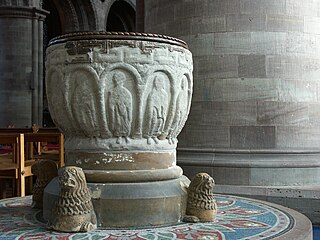
Robert Foliot was a medieval Bishop of Hereford in England. He was a relative of a number of English ecclesiastics, including Gilbert Foliot, one of his predecessors at Hereford. After serving Alexander, Bishop of Lincoln as a clerk, he became a clerk of Henry of Blois, the Bishop of Winchester and brother of King Stephen of England. He attended the Council of Reims in 1148, where another relative, Robert de Chesney, was elected as Bishop of Hereford. Chesney then secured the office of Archdeacon of Oxford for Foliot.

Hugh de Mapenor was a medieval Bishop of Hereford. Although educated and given the title of magister, or "master", the details of his schooling are unknown. Mapenor was a clerk for Giles de Braose, his predecessor as bishop. Later, Mapenor served as Dean of Hereford before being elected as bishop against the wishes of King John of England. During his short episcopate, he supported John's son and successor King Henry III of England, and was active in his diocese, as a number of surviving documents show. He also served as a diplomat for the king.
Hugh Foliot was a medieval Bishop of Hereford. Related somehow to his predecessor at Hereford, he served as a priest and papal judge as well as being an unsuccessful candidate as Bishop of St David's in Wales. In 1219, he was appointed Bishop of Hereford. During his time in office, he mostly attended to ecclesiastical duties, but did occasionally serve as a royal administrator. He helped found a hospital and a priory, and died in 1234 after a months-long illness.
Ralph of Maidstone was a medieval Bishop of Hereford.
John de Breton was a medieval Bishop of Hereford. He served as a royal justice and sheriff before being nominated to Hereford. He is sometimes credited with the legal treatise Britton; but in its current form Breton cannot be the author as the work refers to laws written 15 years after the bishop's death.
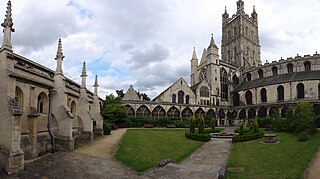
The Dean of Gloucester is the head and chair of the chapter of canons - the ruling body of Gloucester Cathedral - and senior priest of the Diocese of Gloucester. The dean and chapter are based at Gloucester Cathedral. The cathedral is the mother church of the Diocese of Gloucester and seat of the Bishop of Gloucester.
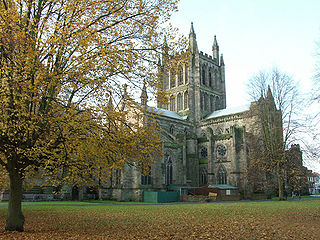
The Dean of Hereford is the head and chair of the chapter of canons, the ruling body of Hereford Cathedral. The dean and chapter are based at the Cathedral Church of Blessed Virgin Mary and St Ethelbert in Hereford. The cathedral is the mother church of the Diocese of Hereford and seat of the Bishop of Hereford.
Ralph Foliot was a medieval English clergyman and royal justice.
Charles Booth, D.C.L. was a sixteenth-century clergyman who served as the Bishop of Hereford from 1516 to 1535.

John Balderston was an academic at the University of Cambridge, master of Emmanuel College and twice vice-chancellor of the university.
John Hills, D.D. was a priest and academic in the late 16th and early 17th centuries.
Jonathan Browne was an Anglican clergyman, Dean of Hereford from 1637 until his death.
Silvanus Griffiths was an Anglican priest in the 17th century.








